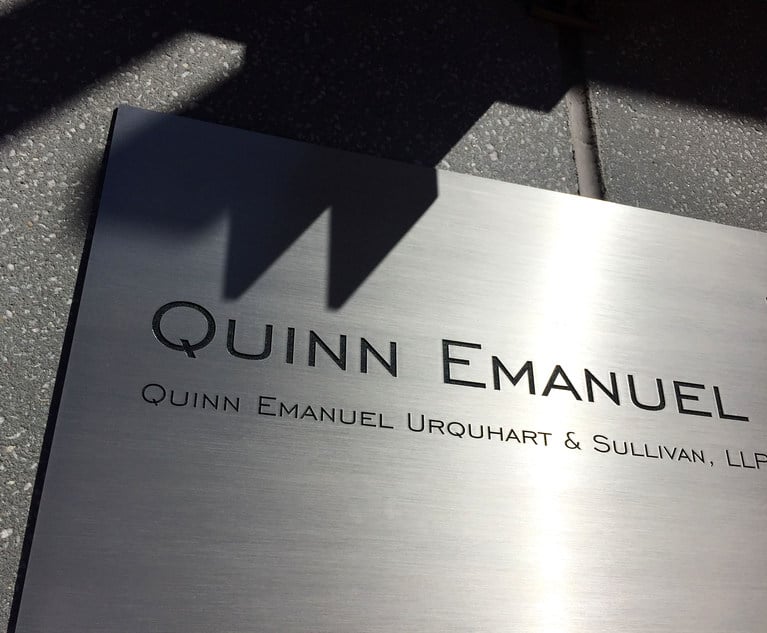Lawyer numbers rise across UK top 50 as mergers continue to drive growth
Lawyer headcount at the UK's 50 largest firms grew by more than 5% during 2015-16
September 23, 2016 at 04:10 AM
4 minute read
The number of lawyers across the UK top 50 firms grew by more than 5% in 2015-16, as the country's largest law firms continue to expand their horizons.
The total number of lawyers across the 50 firms now stands at almost 48,200, up 5.5% on last year's figure of 45,655, driven in large part by continued consolidation in the market.
UK top 50 firms that grew significantly as a result of mergers during the past financial year include Clyde & Co, which tied up with Scottish firm Simpson & Marwick and Australian firm Lee & Lyons; and Irwin Mitchell, which took over Thomas Eggar in December 2015.
The mergers saw Clydes' total lawyer numbers grow by 16% from 1,601 in 2014-15 to 1,864, while Irwin Mitchell's tie-up saw its lawyer count rise by 26% to 972 from 769.
Other mergers during the financial year included Blake Morgan's tie-up with Westminster firm Piper Smith Watton in August 2015; Weightmans' acquisition of Leeds firm Ford & Warren in July 2015; Taylor Wessing's merger with Dutch firm Deterink last September; and Kennedys' combination with Denmark's Erritzoe in December.
Elsewhere, Shakespeare Martineau, which was formed by the June 2015 merger of SGH Martineau and Shakespeares, entered the UK top 50 rankings for the first time in 50th place, boasting a post-merger lawyer headcount of 334 – a figure higher than eight other firms in the top 50.
By total lawyers, the five smallest firms in the UK top 50 are Macfarlanes (309), Trowers & Hamlins (299), Burges Salmon (296), Travers Smith (289) and Ince & Co (245).
At other end of the scale are the sprawling verein firms, led by DLA Piper with 3,730 lawyers, followed by Norton Rose Fulbright (3,372), CMS (2,610) and Hogan Lovells (2,516). The four global magic circle firms complete the top eight firms by lawyer count, with Clifford Chance (CC) the largest with 2,503 lawyers and Freshfields Bruckhaus Deringer the smallest of the quartet, with 2,056.
Leverage – the ratio of lawyers to equity partners – also varies widely throughout the UK top 50, ranging from 15.7:1 at DWF down to Ince & Co at 2:1. The average leverage ratio across the top 50 now stands at 5.8, slightly down on 2014-15′s figure of 6.2.
DLA Piper, the largest firm by lawyer count, has a leverage ratio of 7:1, and the firm's CEO Simon Levine argues that high leverage can be a positive thing. "We have always had a pretty diverse business; both geographically and from a product and service perspective, so having a large leverage is a good thing," he explains. "It also means we are able to take on talent and develop them through to partnership – as we are doing now, promoting more of our own people to partnership."
While profit per equity partner is still intensely scrutinised as a key metric of law firm performance, it continues to comes in for criticism, with Levine describing it as "meaningless" due to the widely differing partnership structures among top UK firms
As a consequence, revenue per lawyer (RPL) is seen by many as a more accurate yardstick for performance. During 2015-16, the average RPL across the UK top 50 fell slightly, from £341,000 in 2014-15 to £338,000, an indicator of the struggles firms faced during 2015-16 amid market uncertainty in the run-up to the European Union referendum.
Top performers among the UK top 50 include Freshfields Bruckhaus Deringer and Allen & Overy, both of which bumped up their RPL figure by 8%, to £645,400 and £634,200 respectively.
Linklaters and CC follow with RPL of £594,300 and £553,700, while Macfarlanes is the only non-magic circle firm with RPL above £500,000, coming in at £521,800 this year.
This content has been archived. It is available through our partners, LexisNexis® and Bloomberg Law.
To view this content, please continue to their sites.
Not a Lexis Subscriber?
Subscribe Now
Not a Bloomberg Law Subscriber?
Subscribe Now
NOT FOR REPRINT
© 2025 ALM Global, LLC, All Rights Reserved. Request academic re-use from www.copyright.com. All other uses, submit a request to [email protected]. For more information visit Asset & Logo Licensing.
You Might Like
View All
X Ordered to Release Data by German Court Amid Election Interference Concerns

Quinn Emanuel's Hamburg Managing Partner and Four-Lawyer Team Jump to Willkie Farr

Trump ICC Sanctions Condemned as ‘Brazen Attack’ on International Law

U.S.- China Trade War: Lawyers Label WTO Dispute Pointless, Clients Have Their Hands Tied
Trending Stories
- 1Trump's DOJ Delays Releasing Jan. 6 FBI Agents List Under Consent Order
- 2Securities Report Says That 2024 Settlements Passed a Total of $5.2B
- 3'Intrusive' Parental Supervision Orders Are Illegal, NY Appeals Court Says
- 4Federal Laws Also Preempt State's Swipe Fee Law on Out-of-State Banks, Judge Rules
- 5Judge Grills DOJ on Trump’s Birthright Citizenship Executive Order
Who Got The Work
J. Brugh Lower of Gibbons has entered an appearance for industrial equipment supplier Devco Corporation in a pending trademark infringement lawsuit. The suit, accusing the defendant of selling knock-off Graco products, was filed Dec. 18 in New Jersey District Court by Rivkin Radler on behalf of Graco Inc. and Graco Minnesota. The case, assigned to U.S. District Judge Zahid N. Quraishi, is 3:24-cv-11294, Graco Inc. et al v. Devco Corporation.
Who Got The Work
Rebecca Maller-Stein and Kent A. Yalowitz of Arnold & Porter Kaye Scholer have entered their appearances for Hanaco Venture Capital and its executives, Lior Prosor and David Frankel, in a pending securities lawsuit. The action, filed on Dec. 24 in New York Southern District Court by Zell, Aron & Co. on behalf of Goldeneye Advisors, accuses the defendants of negligently and fraudulently managing the plaintiff's $1 million investment. The case, assigned to U.S. District Judge Vernon S. Broderick, is 1:24-cv-09918, Goldeneye Advisors, LLC v. Hanaco Venture Capital, Ltd. et al.
Who Got The Work
Attorneys from A&O Shearman has stepped in as defense counsel for Toronto-Dominion Bank and other defendants in a pending securities class action. The suit, filed Dec. 11 in New York Southern District Court by Bleichmar Fonti & Auld, accuses the defendants of concealing the bank's 'pervasive' deficiencies in regards to its compliance with the Bank Secrecy Act and the quality of its anti-money laundering controls. The case, assigned to U.S. District Judge Arun Subramanian, is 1:24-cv-09445, Gonzalez v. The Toronto-Dominion Bank et al.
Who Got The Work
Crown Castle International, a Pennsylvania company providing shared communications infrastructure, has turned to Luke D. Wolf of Gordon Rees Scully Mansukhani to fend off a pending breach-of-contract lawsuit. The court action, filed Nov. 25 in Michigan Eastern District Court by Hooper Hathaway PC on behalf of The Town Residences LLC, accuses Crown Castle of failing to transfer approximately $30,000 in utility payments from T-Mobile in breach of a roof-top lease and assignment agreement. The case, assigned to U.S. District Judge Susan K. Declercq, is 2:24-cv-13131, The Town Residences LLC v. T-Mobile US, Inc. et al.
Who Got The Work
Wilfred P. Coronato and Daniel M. Schwartz of McCarter & English have stepped in as defense counsel to Electrolux Home Products Inc. in a pending product liability lawsuit. The court action, filed Nov. 26 in New York Eastern District Court by Poulos Lopiccolo PC and Nagel Rice LLP on behalf of David Stern, alleges that the defendant's refrigerators’ drawers and shelving repeatedly break and fall apart within months after purchase. The case, assigned to U.S. District Judge Joan M. Azrack, is 2:24-cv-08204, Stern v. Electrolux Home Products, Inc.
Featured Firms
Law Offices of Gary Martin Hays & Associates, P.C.
(470) 294-1674
Law Offices of Mark E. Salomone
(857) 444-6468
Smith & Hassler
(713) 739-1250









